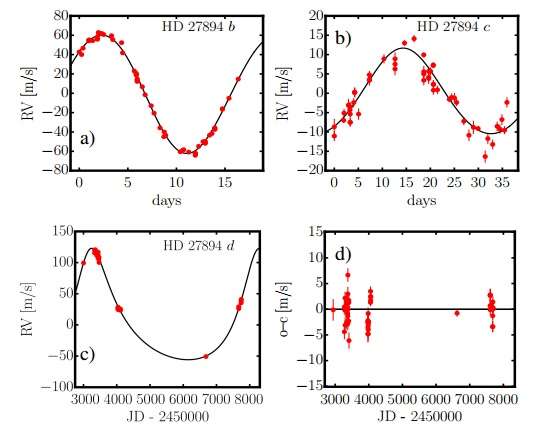June 12, 2017 report
Two new massive planets detected around the star HD 27894

Gas giant planet HD 27894 b appears to have at least two massive companions, according to a new study published June 1 in a paper on arXiv.org. One of the newly discovered alien worlds is a Saturn-mass planet, while the other one is a cold exoworld several times more massive than Jupiter.
Located about 138 light years away from the Earth, HD 27894 is a non-active solar-type star of spectral type K2V approximately 20 percent less massive than the sun. In 2005, HD 27894 b was detected using radial velocity measurements conducted with the use of the European Southern Observatory's (ESO) High Accuracy Radial velocity Planet Searcher (HARPS) at the La Silla Observatory in Chile.
Given that HD 27894 has a low declination, visual brightness of 9.36 mag and a slow rotation period of about 44 days, it is an excellent target for HARPS observations. So after the discovery of HD 27894 b, researchers monitored the star using this spectrograph during three observational campaigns in 2006, 2013 and 2016.
Now, an international team of astronomers led by Trifon Trifonov of the Max Planck Institute for Astronomy in Germany has analyzed the available archival and new HARPS data in order to find additional planets in the HD 27894 system. The study detected the presence of two gas giant exoplanets, which received designations HD 27894 c and HD 27894 d.
"In this paper, we present an updated orbital configuration for the HD 27894 system; according to our self-consistent N-body analysis of the RV data, the system is composed of three planets, the inner two likely in a 2:1 MMR (mean motion resonance)," the researchers wrote in the paper.
According to the research, HD 27894 c has a mass of about 0.16 Jupiter masses, an orbital period of 36 days and is circling its host at a distance of 0.2 AU. HD 27894 d is much more massive, with a mass of approximately 5.4 Jupiter masses. The Jovian planet is also orbiting the star at a much larger distance than the other two worlds in the system. It takes HD 27894 d over 14 years to complete one full orbit, as it is located almost 5.5 AU from the host.
Moreover, the researchers noted that their new findings show that this planetary system has a unique configuration.
"The co-existence of a massive, distant, and moderately eccentric Jovian planet and a possibly resonant inner pair of massive planets makes the HD 27984 system truly unique," the paper reads.
The authors reveal that such a configuration provides important hints about the formation and evolution of this system. They assume that the inner pair of planets has probably been trapped in a 2:1 MMR by smooth migration capture, while the outer planet migrated to its current distant position before the circumstellar disk evaporated, thus halting the migration.
"The planetary system around HD 27894 is important for probing planetary formation and evolution scenarios and illustrates the importance of further follow-up of radial velocity planet hosts," the astronomers concluded.
More information: arxiv.org/pdf/1706.00509.pdf
© 2017 Phys.org



















